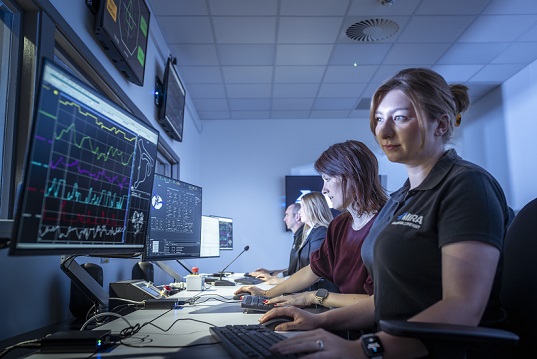Automotive test and engineering facility at HORIBA MIRA creates driving simulator centre for vehicle attribute engineering studies
Automotive engineering, test and development consultancy HORIBA MIRA has launched its new Driving Simulator Centre at its UK head office in Nuneaton, Warwickshire. Featuring state of the art driver-in-the-loop (DiL) simulator technology, supported by HORIBA MIRA’s high levels of experience in engineering service and consultancy, the Driving Simulator Centre maintains HORIBA MIRA’s position as a large, well-established and global provider of vehicle attribute engineering expertise.
Over £4 million has been invested in the new facility to enable established automotive OEMs, new start-up vehicle manufacturers and tier one suppliers to develop new vehicles that reflect their specific brand characteristics. By using virtual tools, the new capability will deliver vehicle attributes that conform to the brand requirements faster, more sustainably and at a reduced development cost.
Dynamic Motion Driving Simulator
At the heart of the new Driving Simulator Centre is the UK’s first VI-grade DiM250 Dynamic Simulator, one of the world’s most advanced and high-performance dynamic motion driving simulators. Use of the simulator significantly reduces the need for physical vehicle testing and prototypes, reducing associated carbon emissions. At full reduction, one developed vehicle model using the VI-grade simulator could avoid a maximum potential of 14,000 tonnes of carbon dioxide equivalent (CO2e), according to HORIBA MIRA.
Customers utilising the organisation’s Driving Simulator Centre will also get access to its VI-grade COMPACT simulator, acquired in 2021, conveniently located within the same facility.
The Driving Simulator Centre, together with HORIBA MIRA’s own subjective led attribute methodology, which it developed, puts the human-in-the-loop at the very start of the virtual engineering series. Attribute development engineers can make accurate and unlimited comparisons quickly and at lower cost, often at the flick of a switch. This is of particular importance when working to balance conflicting attributes to achieve an optimised vehicle. This results in more informed subjective-led decisions being made throughout the entire development cycle rather than waiting for a physical prototype – and in many cases can significantly reduce the number of prototypes required.
COMPACT simulator
The COMPACT Simulator is a piece of equipment that has all the main functions of other VI-Grade simulators but with a reduced size to take up a smaller footprint and can be sited in an office.
It has a carbon-fibre cockpit with screen and controls so can be used for DiL simulations. As such, it’s described by VI-Grade as an ideal tool for automotive OEMs wanting to prepare models to be used for a more advanced simulator (both STATIC and DiM) and needing to quickly test specific components.
It can also be used by other companies within the automotive industry supply chain as a means of checking the performance of their components within more complex vehicle models as part of a HiL simulation.
Attribute focused prototyping
The Driving Simulator Centre enables automotive companies to conduct virtual development across many automotive applications. Predominantly this is focused on the driven attributes, which include vehicle dynamics, noise, vibration, and harshness (NVH), as well as drivability, but also includes holistic engineering across capabilities growing in complexity and importance, such as advanced driver assist systems (ADAS), human machine interface (HMI) and x-in-the-loop (XiL) applications. (XiL includes the use of specific hardware or software within the simulation exercise).
Having had a significant role in providing automotive engineering, test and development services for almost eight decades, the addition of crucial simulation tools is an example of how the organisation is continuing to align its engineering capabilities and infrastructure to support the industry as it navigates the significant changes that it’s currently going through. HORIBA MIRA believes that the Driving Simulator Centre is a key enabler of net zero ambitions due to the fact that it significantly reduces the industry’s reliance on carbon-intensive physical prototypes.
Alongside the Driving Simulator Centre, HORIBA MIRA has also made significant investments in its propulsion and electromobility capabilities, as well as developing the MIRA Technology Park in Nuneaton, which is now home to 40+ engineering companies working on emerging technologies that are contributing towards the automotive industry’s ambitions of realising net zero.
According to Declan Allen, Managing Director at HORIBA MIRA, through the newly launched Driving Simulator Centre, the speed, cost and complexity of refining driven vehicle attributes to meet today’s changing customer expectations is significantly reduced.
“This new facility enhances HORIBA MIRA’s capabilities and is an enabler of its attribute-led development methodology, while also being a critical tool supporting complex engineering developments across ADAS, HMI and XiL,” he says.
Guido Bairati, Managing Director at VI-grade commented on the selection of VI-grade and its simulators as the tools of choice for HORIBA MIRA and its Driving Simulator Centre.
“With a long and respected automotive engineering history, we’re excited that both VI-grade’s DiM250 Dynamic Simulator and COMPACT simulator will be supporting global automotive manufacturers and suppliers as they look ahead to future vehicle programmes and engineering challenges,” he concludes.
- UK manufacturing steps up to COVID-19 crisis - April 2, 2020
- Clustering Innovation - March 12, 2020
- A Global Monitor - March 6, 2020

